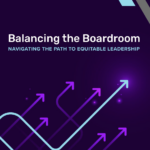
by Nycole Walsh
Women’s History Month is a time to celebrate progress, but it’s also an opportunity to examine the disparities that still remain. When it comes to leadership development, women continue to face significant roadblocks – many of which are deeply ingrained in the way we approach professional growth.
Kickstand’s Balancing the Boardroom report highlighted a persistent gender divide in leadership development, confidence, and access. If we want to create a truly equitable workplace, we need to ask ourselves: Are we missing the mark on preparing and supporting women for leadership opportunities?
Ambition vs. attainability
While men and women generally feel equally dedicated and skilled as leaders, there’s a striking difference when it comes to confidence: men were 17% more likely to express confidence in their ability to make tough calls at the highest levels of leadership. This is in part due to the lessons taught to us from an early age. Men were a whopping 267% more likely than women to say they were encouraged to be “brave,” and 62% more likely to say they were encouraged to be “confident.”
Even though more than half of women in leadership positions (59%) have their eyes set on the C-Suite, men were 30% more likely to say joining the senior corporate ranks feels realistically achievable within their organization. And despite the belief that things are “getting better” for women, Gen Z respondents were a shocking 47% more likely than other cohorts to say they wouldn’t be able to achieve these goals.
All of this goes to show that while women want to progress in their careers, they might not believe that they can. Some of this is due to societal conditioning, but much of it has to do with how employers show up (or, let’s be honest, don’t show up) for their female employees.
Unequal access to leadership-building opportunities
Even when women take proactive measures to develop their leadership skills they face systemic barriers – often at the hands of their employers. For example, women were 208% more likely than men to say their employer does not support efforts to apply for speaking engagements. Without this support, women are unable to access the career benefits presented by speaking engagements, and 21% more likely than men to have never applied for such an opportunity.
To make matters worse, women were 52% more likely to report a lack of employer support for career coaching or mentoring. Public speaking, networking with senior leaders, and membership opportunities are all critical pathways to leadership. Yet, many women aren’t provided the same access and support as their male counterparts.
This lack of support doesn’t just slow individual career growth; it reinforces the systemic barriers that keep leadership pipelines overwhelmingly male. When organizations fail to invest in women’s professional development, they’re not just limiting opportunities for women; they’re missing out on diverse perspectives that drive innovation and success.
The “penalty” of parenthood
Those balancing career ambitions with family life face their own set of challenges on top of what we’ve listed above. While women were 143% more likely than men to say they’ve passed up a valuable professional opportunity due to childcare responsibilities, systemic bias towards mothers and female caregivers presents an additional (and foreboding) obstacle.
More than half of women with children (51%) have been questioned about their ability to balance family and work when applying for a job or promotion. Unsurprisingly, only 33% of men have been asked the same question.
Why do we assume men can “handle” having a family and a career at the same time? Is it because of outdated, sexist beliefs that women’s ambitions should be confined to family life? Or that men are somehow supposed to be the breadwinners? Whatever the reason, these deep-seated misconceptions mean women are twice as likely as men to report being passed over for a promotion while on parental leave.
Changing the narrative
Addressing the gender divide in leadership development isn’t just about fixing a “confidence gap” or encouraging women to “lean in.” It requires employers to enact intentional systemic change. Organizations that are serious about gender equity can actively support women’s leadership development by providing resources for speaking engagements, networking, and mentorship.
They can also ensure workplace policies uplift parents of all genders by offering equal parental leave and working to eliminate biases in hiring and promotion decisions. Above all, challenging outdated expectations must become a priority.
By fostering an environment where confidence and leadership potential are nurtured equally in men and women, we can move beyond performative allyship and build workplaces where potential isn’t determined by gender.
For a deep dive on these insights (and more), download our full Balancing the Boardroom: Navigating the Path to Equitable Leadership report today.




